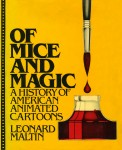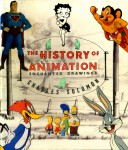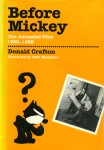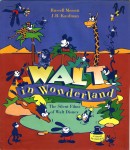Books 12 Apr 2007 07:03 am
More history books
- Of course, once you open a can of worms, lots of critters wander out unexpectedly.
I started writing about animation books with a focus on the history books, but I reealized there were many more books that I should list.
 Leonard Maltin‘s Of Mice and Magic originally came out in 1980 and has had a number of revised editions. It was the first big-time book to call itself a “History of Animated Cartoons,” and it does a good job of cataloging a lot of material and reporting on it. The book puts the films in order by studio which is, in some ways, helpful. This is especially true if you’re searching for information about a specific film. Jerry Beck had a large hand in writing this book.
Leonard Maltin‘s Of Mice and Magic originally came out in 1980 and has had a number of revised editions. It was the first big-time book to call itself a “History of Animated Cartoons,” and it does a good job of cataloging a lot of material and reporting on it. The book puts the films in order by studio which is, in some ways, helpful. This is especially true if you’re searching for information about a specific film. Jerry Beck had a large hand in writing this book.
The best part of the book is the attention it gives to some of the New York studios: Terrytoons and Paramount, in particular. These studios are usually given short shrift by animation histories; there’s just so little written about them.
 Charles Solomon wrote a larger – more of a coffetable book – history of animation. Enchanted Drawings: The History of Animation covers the traditional American Studio history and attacks it in a mostly chronological order. However, the book also gives large focus to the International and Independent scenes. These are traditionally ignored in most of the books, yet, here, they’re discussed in some detail in a confident, articulate style. Plenty of beautiful, color illustrations fill the book and add to its value.
Charles Solomon wrote a larger – more of a coffetable book – history of animation. Enchanted Drawings: The History of Animation covers the traditional American Studio history and attacks it in a mostly chronological order. However, the book also gives large focus to the International and Independent scenes. These are traditionally ignored in most of the books, yet, here, they’re discussed in some detail in a confident, articulate style. Plenty of beautiful, color illustrations fill the book and add to its value.
You can get a good indication of the caliber of this book from its cover. The characters illustrated come in many forms, yet in every case the best looking versions of these characters was chosen. There’s good taste in this book from cover to cover.
There are two books about Silent film animation. Other than the Canemaker books on Winsor McCay and Felix the Cat, these are the only two books I’d like to highlight, and they’re both important ones.
 With Before Mickey, Donald Crafton has written a very strong book on the history of silent animated films. He carefully points to all of the great and not-so-great animation filmmakers and studios. From Winsor McCay to J.R.Bray to Otto Messmer, Crafton doesn’t miss much, and if he does, I can’t find it. Given the difficulty just in viewing many of these films it’s easy to say that the amount of research for this book was obviously enormous.
With Before Mickey, Donald Crafton has written a very strong book on the history of silent animated films. He carefully points to all of the great and not-so-great animation filmmakers and studios. From Winsor McCay to J.R.Bray to Otto Messmer, Crafton doesn’t miss much, and if he does, I can’t find it. Given the difficulty just in viewing many of these films it’s easy to say that the amount of research for this book was obviously enormous.
Since I have a real curiosity about the period, I found the book riveting. Few people have seen many of the films discussed, so it’s not a book that many are going to want. However, I’m pleased that it is one of the most solid animation histories out there. If I have any complaints it’s that the writing style is a bit dry, but that’s quibbling. I treasure the book.
 Walt In Wonderland is necessary to any big Disney fans. Russell Merritt and J.B. Kaufman have done a brilliant job on this book. It gives strong attention to the silent films of Disney: the Alice comedies and the Oswald shorts. There’s a good history of the studio from Kansas City to Hollywood with lots of illustrations.
Walt In Wonderland is necessary to any big Disney fans. Russell Merritt and J.B. Kaufman have done a brilliant job on this book. It gives strong attention to the silent films of Disney: the Alice comedies and the Oswald shorts. There’s a good history of the studio from Kansas City to Hollywood with lots of illustrations.
The book not only features a history of the studio, but it shows the production methods used and invented in what was an ever-changing process back then.
Merritt and Kaufman have a more recent book, Walt Disney’s Silly Symphonies: A Companion to the Classic Cartoon Series, is a book I have on order and haven’t yet read. If what I’ve heard about it is accurate, I expect it’ll be another great book. Once I’ve read it, I’ll let you know what I think.
Next time, finally, books about the craft rather than the history.

on 12 Apr 2007 at 1:00 pm 1.Eddie Fitzgerald said …
I found the Solomon book to be a big disappointment. The color quality was good and some of the pictures were worth having but the last third of the book was full of hacked-out Saturday Morning TV promotion. If you want a lot of pictures of Scooby Doo-type stuff then this is the book for you.
Even the independents got rough treatment in the graphics. A lot of the pictures don’t show the films to best advantage and the layouts, the positioning of graphics on the page and the proportion of print to text, were unimaginative in the extreme. It’s odd that someone who writes about art would choose such an unartistic format.
on 13 Apr 2007 at 11:57 am 2.Eddie Fitzgerald said …
I neglected to say that Solomon might not have been responsible for some of the book’s graphic problems. I’ve never published a book but I’ve heard horror stories from people who have. You can’t just hand over the pictures to an art director and expect that everything will turn out right.
I liked the layouts in Cabarga’s book on the Fleischers.
on 30 Aug 2013 at 1:46 pm 3.Karyn Boucher said …
Hello just wanted to give you a quick heads up. The text in your post seem to be running off the screen in Chrome. I’m not sure if this is a formatting issue or something to do with browser compatibility but I figured I’d post to let you know. The layout look great though! Hope you get the issue fixed soon. Cheers